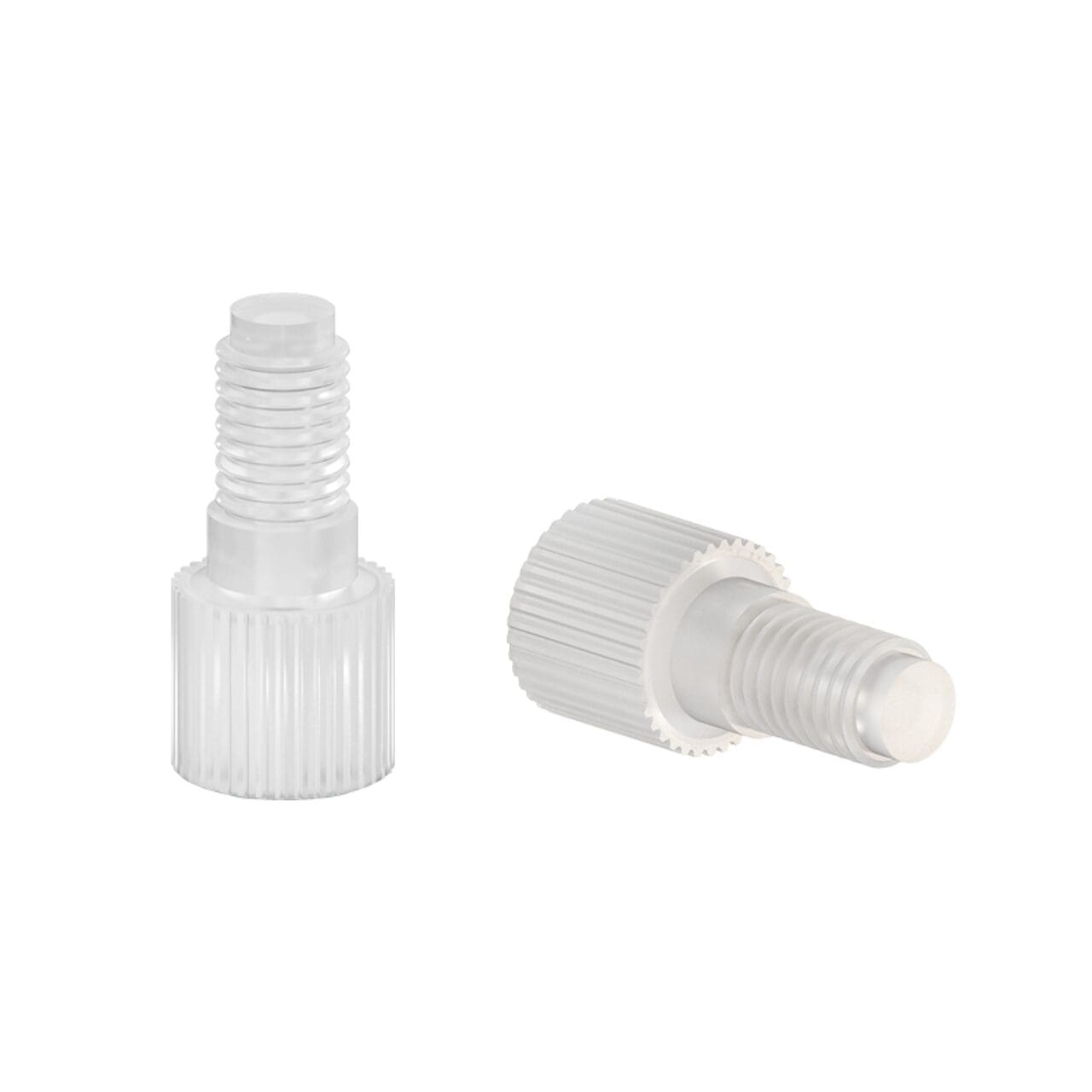Two widely used thermoplastics in fluid handling and microfluidics are Polypropylene (PP) and Nylon. Both offer unique combinations of chemical resistance, mechanical strength, and versatility, making them staples across industries ranging from medical devices to automotive components and consumer goods.
In microfluidics, small differences in flexibility, durability, and moisture sensitivity can have a big impact on flow stability, device integration, and long-term performance.
This article breaks down the similarities and differences between PP and Nylon, provides scenario-based recommendations, and answers common questions to help you select the right material for your setup.
PP vs Nylon: Quick Comparison Table
The table below summarizes the key properties of PP and Nylon, illustrating differences in chemical resistance, mechanical characteristics, and other factors relevant to microfluidic and industrial applications.
| Property | PP | Nylon | Preferred Material |
|---|---|---|---|
| Chemical Resistance | Very good | Good | PP |
| Coefficient of Friction | 0.28 | 0.15 | Nylon |
| Coefficient of Thermal Expansion (between 21 and 100°C) | 8 × 10-5 /K | 8 × 10-5 /K | Both |
| Compressive Strength | 48 MPa | 86 MPa | Nylon |
| Cost | Relatively inexpensive | Relatively inexpensive | PP |
| Dielectric Strength | 35-40 kV/mm | 15.8 kV/mm | PP |
| Elongation | ~400% | 60% | PP |
| Flexural Modulus | 1.2 GPa | 3.1 GPa | Nylon |
| Hardness (Shore D) | 77 | 85 | Nylon |
| Service Temperature | -40°C to 100°C | -40°C to 120°C | Nylon |
| Tensile Strength | 30 MPa | 75 MPa | Nylon |
| Thermal Conductivity | ~0.22 W/m·K | ~0.245 W/m·K | Nylon |
| Water Absorption | less than 0.01% | 0.3% | PP |
💡 Note: The values presented in this table are for reference purposes only. Actual properties may vary depending on the supplier, as factors such as size, grade, and brand can influence performance. Both PP and Nylon are often available with customized specifications to meet specific application requirements.
PP vs Nylon: Material Overview
To better understand how PP and Nylon perform in microfluidics and other domains, it is useful to examine their key properties, characteristics, and typical use cases.
About PP
Polypropylene (PP) is a lightweight thermoplastic known for its chemical resistance, low moisture absorption, and good electrical insulation. Its resilience and stability under exposure to solvents, acids, and bases make it particularly suitable for fluid handling in microfluidic systems, where contamination and material degradation must be minimized.
Beyond microfluidics, PP is widely used in packaging, laboratory containers, consumer goods, and certain automotive components where durability and cost-efficiency are essential.
About Nylon
Nylon, a family of polyamide polymers, is known for its high tensile strength, elasticity, and abrasion resistance. These properties make it ideal for microfluidic applications requiring robust tubing or components that can withstand mechanical stress or repeated bending.
Although its tendency to absorb moisture can affect performance, Nylon’s durability, wear resistance, and thermal tolerance make it a preferred choice in industrial applications, automotive parts, mechanical components, and high-performance textiles.
Side-by-Side Comparison
While PP and Nylon share many traits as versatile thermoplastics, their differences become evident when looking at mechanical performance, chemical resistance, thermal behavior, and typical applications.
Mechanical Properties
Nylon offers higher tensile strength, and resistance to mechanical stress, making it ideal for microfluidic components and tubing that must endure repeated bending or high loads.
PP, while less strong and less elastic, is more lightweight and retains good dimensional stability under standard conditions. Its flexibility is sufficient for most low-stress fluid handling applications.
Chemical & Temperature Resistance
PP excels in chemical resistance and low water absorption, which ensures stable performance in microfluidic systems exposed to moisture or aggressive solvents. Nylon, although resistant to many chemicals, is more prone to moisture absorption, which can reduce tensile strength and affect long-term stability.
Regarding thermal properties, Nylon tolerates slightly higher temperatures, whereas PP maintains performance across moderate temperature ranges.
Both are suitable for typical microfluidic conditions but should be chosen based on fluid type and environmental exposure.
Surface & Electrical Properties
Nylon has a lower coefficient of friction, making it advantageous for components where smooth sliding or low wear is required, such as rollers or seals in fluidic assemblies.
PP offers moderate friction but performs better in electrically insulating applications due to higher dielectric strength, which can be useful in lab or process setups requiring electrical isolation.
Cost
Both PP and Nylon are considered affordable engineering plastics, making them popular choices across industries.
However, PP is typically the more economical option due to its simpler processing and lower raw material cost, while Nylon’s slightly higher price reflects its superior mechanical strength and durability in demanding applications.
Environmental & Sustainability Aspects
Both PP and Nylon are widely used thermoplastics, but they differ in their environmental footprint. For applications prioritizing sustainability and recyclability, PP is typically the more eco-friendly option. It generally has a lower environmental impact due to its simpler production process and higher recyclability.
Nylon, while more durable and long-lasting, requires more energy to produce and generates higher greenhouse gas emissions.
Typical Applications
PP is commonly used in microfluidic fittings and connectors, chemical containers, low-pressure components, and packaging applications where chemical inertness, low cost, and moderate mechanical performance are sufficient.
Nylon is preferred for high-stress microfluidic components, industrial gears, automotive parts, and mechanical devices where strength, wear resistance, and flexibility are essential.
How to Choose Between PP and Nylon?
Choosing between PP and Nylon depends less on which material performs “better” in general, and more on which best fits the functional and environmental requirements of your application. Below are common scenario-based recommendations to help guide your selection.
1. If chemical resistance and moisture stability are critical:
PP is the preferred choice due to its exceptional resistance to most acids, bases, and solvents. Its hydrophobic nature ensures dimensional and mechanical stability even in humid or wet environments, making it ideal for microfluidic systems exposed to aqueous or reactive solutions.
2. If high mechanical strength and wear resistance are required:
Nylon outperforms PP in tensile strength, abrasion resistance, and durability under repeated mechanical stress, making it more suitable for load-bearing or moving components.
3. If operating conditions involve higher temperatures:
Nylon performs better at elevated temperatures, maintaining strength and stiffness where PP may begin to soften. It is more suitable for applications where heat exposure or mechanical load at high temperature is expected.
4. If cost is a deciding factor:
Both materials are cost-effective, but PP remains the more economical option, making it the preferred choice for budget-sensitive projects, while Nylon’s higher price reflects its superior mechanical performance and durability.
5. If environmental impact and recyclability matter:
PP has a lower environmental footprint and is easier to recycle, whereas Nylon manufacturing is more energy-intensive. For sustainable designs or large-scale production where end-of-life considerations are important, PP is generally preferred.
👉 In short:
- Choose PP when you need a lightweight, chemically resistant, moisture-stable, and budget-friendly material.
- Choose Nylon when you need higher mechanical strength, temperature tolerance, and durability under stress.
PP vs Nylon: Frequently Asked Questions
A closer look at common questions helps clarify which material is best suited for specific microfluidic and industrial applications.
Q1: Which material is stronger, PP or Nylon?
Nylon generally has higher tensile and compressive strength, making it better suited for applications that require mechanical durability or load-bearing components. PP, while less strong, still performs well in less mechanically demanding setups.
Q2: How do PP and Nylon compare in chemical resistance?
PP is generally better for chemical resistance and moisture stability, making it more reliable in corrosive or wet environments. Nylon is less resistant and can be affected by acids, oxidizing agents, and moisture absorption.
Q3: Which material is more flexible, PP or Nylon?
Nylon offers superior elasticity and flexibility, which is useful for tubing or parts that need to bend or deform repeatedly. PP is stiffer but can handle certain bending applications without cracking.
Q4: Which material is better for high-temperature applications, PP or Nylon?
Nylon has a higher service temperature range, tolerating continuous exposure up to around 120 °C. For applications with elevated heat, Nylon is generally preferred.
Q5: Which material is more cost-effective, PP or Nylon?
PP is the more cost-effective option, making it ideal for budget-conscious projects. Nylon’s higher price reflects its enhanced mechanical properties and durability.
Q6: When should I choose Nylon over PP?
Nylon is the preferred choice for applications requiring high mechanical strength, abrasion resistance, or durability under high temperatures and repeated stress, such as in industrial or load-bearing microfluidic components.
Q7: When should I choose PP over Nylon?
PP is ideal for applications where chemical resistance, low moisture absorption, and cost-effectiveness are priorities, such as fluid containers, microfluidics connectors, or components exposed to humid or chemically aggressive environments.
💡 Conclusion
Polypropylene (PP) and Nylon are two widely used thermoplastics for fittings and connectors in microfluidics as well as broader industrial applications. Knowing their properties and differences helps you pick the right material for your specific application, ensuring reliable performance and durability.
Stay tuned for more deep dives into material choices for microfluidics, comparing tubing, connectors, and other component materials to help you make the best selection 🔬!
📧 If you have any questions or feedback, please feel free to contact us at contact@darwin-microfluidics.com.
🔗 References
- Substech. Thermoplastic Polyamide (Nylon 6). https://www.substech.com/dokuwiki/doku.php?id=thermoplastic_polyamide_nylon_6
- Substech. Thermoplastic Polypropylene (PP). https://www.substech.com/dokuwiki/doku.php?id=thermoplastic_polypropylene_pp
- CN Polychemer. Polypropylene vs Nylon – A Comprehensive Comparison. https://fr.cnpolychemer.com/news/polypropylene-vs-nylon-a-comprehensive-compa-79045613.html
- Runsom. UV Resistant Plastics: Difference Between Polypropylene and Nylon. https://www.runsom.com/fr/blog/uv-resistant-plastics-difference-between-polypropylene-and-nylon/
- Nylon Granules. Nylon vs PP – Difference Between Two Key Materials. https://nylon-granules.com/fr/nylon-vs-pp-difference-between-two-key-material/
- Engineering Toolbox. Linear Expansion Coefficients. https://www.engineeringtoolbox.com/linear-expansion-coefficients-d_95.html



